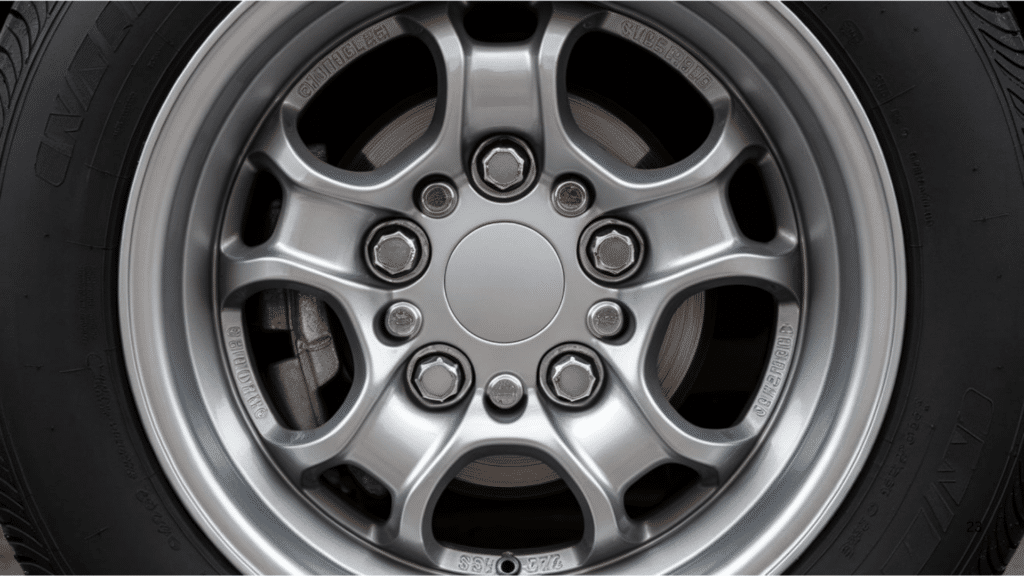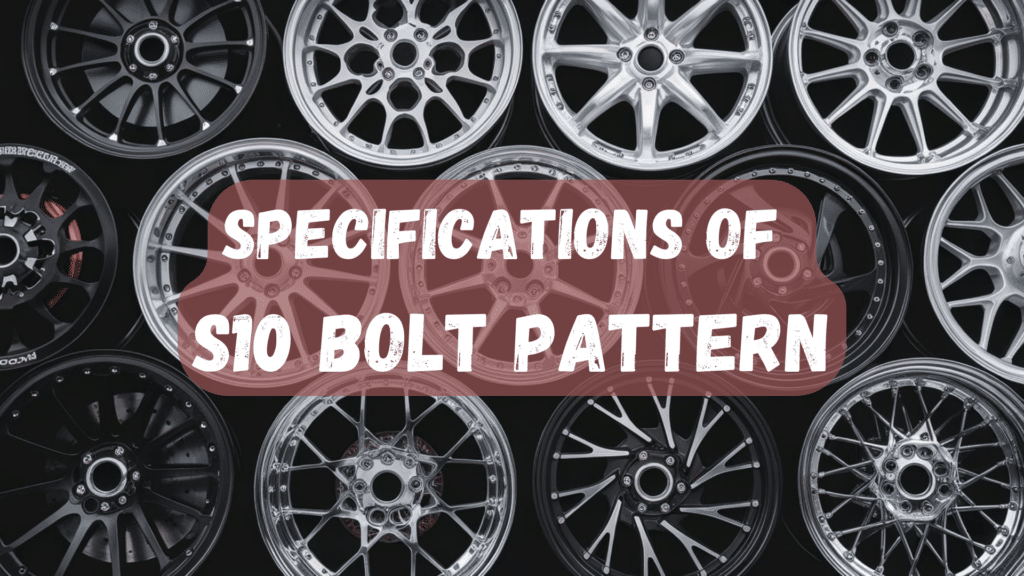When buying new wheels, bolt patterns matter. If you own a Chevrolet S10 or a similar vehicle, you’ve probably come across the term S10 bolt pattern. But what does it mean? And why is it important?
In this blog, you’ll learn:
- What is the S10 bolt pattern, and how do you measure it?
- Why it matters when choosing new wheels.
- Common mistakes people make (and how to avoid them).
Many car owners struggle with wheel fitment issues. The wrong bolt pattern can lead to unsafe driving, poor handling, or wasted money.
But don’t worry, I’ll break it down in simple terms so you can make the right choice. If you’re a beginner or a car enthusiast, you’ll leave knowing exactly what to do next.

Understanding the S10 Bolt Pattern & Its Measurements
If you’re looking at wheels for your S10, you need to understand the bolt pattern first. Get this wrong, and your wheels won’t fit—plain and simple.
So, what is a bolt pattern?
The number of lug holes on the wheel and the distance between them. Think of it as the “fingerprint” of your wheel fitment.
Not all bolt patterns are the same, and using the wrong one can cause serious issues.
The S10 Bolt Pattern: The Basics
The Chevrolet S10 has a bolt pattern of:
- 5×4.75 inches (or 5×120.7mm in metric)
- This means 5 lug holes, evenly spaced in a circle
- The distance between opposite holes is 4.75 inches
How to Measure It Yourself
If you want to check the bolt pattern on your S10, here’s how:
- Count the lug holes (You should see five).
- Measure from the center of one lug to the outer edge of the opposite lug.
- If it reads 4.75 inches, you’ve got the right pattern.
Why This Matters
Using the correct bolt pattern ensures:
A secure fit – No wobbling or stress on the lugs.
Better handling – The right wheels keep your truck stable.
Less hassle – No need for adapters or unsafe modifications.
Now that you know the basics, let’s choose the right wheels for your S10.
What Are the Factors to Consider When Selecting Wheels with an S10 Bolt Pattern?
I get it. You want wheels that fit and look good. But if you don’t pay attention to a few key things, you might have wheels that don’t work for your truck.
So, what should you consider?
1. The Bolt Pattern Itself
This seems obvious, but double-check the bolt pattern before buying. The S10 bolt pattern is 5×4.75 inches (or 5×120.7mm). If the pattern doesn’t match, the wheels won’t fit—no exceptions.
2. Offset and Backspacing
These affect how far the wheels stick out or tuck in.
- Offset: The distance from the wheel’s centerline to the mounting surface.
- Backspacing: The space from the mounting surface to the wheel’s inner edge.
3. Hub-Centric vs. Lug-Centric
Some wheels center on the hub (hub-centric), while others rely on lug nuts (lug-centric). Hub-centric wheels are more stable and prevent vibration.
You might need hub rings for a snug fit if your wheels are lug-centric.
4. Lug Nut Type
Not all lug nuts are the same. Some wheels need conical seat lug nuts, while others use ball seat or mag-style nuts. The wrong ones? They won’t secure the wheel properly.
5. Wheel Material and Weight
- Steel wheels: Strong but heavy. Great for work trucks.
- Alloy wheels: Lighter, better performance, but pricier.
Which one’s right for you? Depends on how you use your truck.
6. Tire Size Compatibility
Bigger wheels? You may need bigger tires.
Smaller wheels? You could lose ground clearance.
Make sure your wheel choice works with your tire goals.
Get the right fit so you don’t waste money—or worse, end up with a truck that handles poorly.
How to Install Wheels with an S10 Bolt Pattern
Installing wheels is simple if done right. Here’s how:
What You’ll Need:
- Jack & jack stands
- Lug wrench & torque wrench
- Wheel chocks
- Wire brush
Steps to Follow:
- Park on a flat surface. Engage the parking brake and use wheel chocks.
- Loosen lug nuts slightly before lifting the truck.
- Jack up the truck and secure it with jack stands.
- Remove the old wheel and clean the hub with a wire brush.
- Mount the new wheel, aligning the bolt holes.
- Hand-tighten lug nuts to prevent cross-threading.
- Lower the truck slightly, then tighten the lug nuts in a star pattern with a torque wrench.
- Lower completely and re-torque after driving 50-100 miles.
That’s it—safe and easy!
Common Mistakes to Avoid During Installation
I’ve seen it happen too often—people rush through wheel installation and end up with loose bolts, vibration issues, or worse. Don’t make the same mistakes.
1. Not Checking the Bolt Pattern First
Before you even buy new wheels, double-check the bolt pattern. The S10 typically has a 5×4.75″ (5×120.7mm) pattern, but some models may vary.
Wrong pattern = wheels that won’t fit.
2. Over-Tightening or Under-Tightening Lug Nuts
Lug nuts must be torqued properly—not too tight or loose. Use a torque wrench and follow the manufacturer’s specs.
If you over-tighten, you risk warping the rotor. If you under-tighten, the wheel could come off while driving.
3. Ignoring the Star Pattern Tightening Method
Never tighten lug nuts in a circle. Instead, use a star pattern—tighten one, then move to the opposite side. This keeps the wheel balanced and prevents misalignment.
4. Using the Wrong Lug Nuts
Not all lug nuts are the same. Some are cone-shaped, and some are ball-shaped. If you use the wrong type, the wheel may not seat properly, leading to vibrations or damage.
5. Forgetting to Re-Torque After Driving
Wheels can shift slightly after the first 50-100 miles of driving. Always check and re-torque your lug nuts to avoid loosening. It’s a simple step that can prevent serious issues.
Mistakes like these are easy to make—but also easy to avoid. Take your time, follow the right steps, and your S10 wheels will be safe and secure.
Applications of the S10 Bolt Pattern in Different Vehicles
The S10 bolt pattern isn’t just for the Chevy S10. It’s used on many vehicles, making it a popular choice for wheel swaps and upgrades.
But here’s something you might not know… It’s not just trucks.
You’ll find the S10 bolt pattern on:
- Chevy S10 and GMC Sonoma – The original models.
- Chevy Blazer and GMC Jimmy – SUVs with the same setup.
- Older muscle cars – Some Camaros, Chevelles, and Novas.
- Custom builds – Hot rods and classic trucks using aftermarket wheels.
If you own one of these vehicles, you have options. You can swap wheels between models or find aftermarket rims that fit perfectly.
So, before you buy new wheels, check the bolt pattern, offset, and backspacing. A little research now can save you money and frustration later.
Benefits of the S10 Bolt Pattern
I’ve seen a lot of people overlook bolt patterns when choosing wheels. But trust me, they matter.
1. More Wheel Options
The S10 bolt pattern (5×4.75 inches) is the most common among GM vehicles. That means more wheels to choose from.
Whether looking for stock replacements or aftermarket upgrades, you won’t be stuck with limited options.
2. Easy to Find Parts
Have you ever tried looking for a rare bolt pattern? It’s a headache. However, with the S10 pattern, lug nuts, spacers, and adapters are easy to find. That makes maintenance and upgrades simpler.
3. Strong and Reliable
This bolt pattern is designed to handle weight and stress well. It works for daily driving, hauling, and even some off-road setups.
You won’t have to worry about weak wheel connections.
4. Compatibility With Other Vehicles
Want to swap wheels with another GM car? You probably can.
The S10 bolt pattern is shared by many classic Chevys and even some sports cars. That means more flexibility when looking for wheels.
5. Affordable Upgrades
Because this bolt pattern is so common, wheels are cheaper than rare or custom-fit patterns. You get more choices without emptying your wallet.
That’s why the S10 bolt pattern is a great choice. It’s versatile, strong, and practical.
If you need new wheels, you won’t have to search forever—or spend a fortune.
List of Vehicles Using the S10 Bolt Pattern
You’re in the right place if you’re wondering which vehicles share the S10 bolt pattern.
Why does this matter?
If you’re looking for replacement wheels or upgrades, knowing which cars share this pattern expands your options. More choices, better deals.
Vehicles with the S10 Bolt Pattern
| Make | Model | Years | Notes |
|---|---|---|---|
| Chevrolet | S10 Pickup | 1982-2004 | Most trims |
| Chevrolet | Blazer (2WD) | 1983-2005 | Excludes 4WD |
| GMC | Sonoma | 1982-2004 | S10 twin |
| GMC | Jimmy (2WD) | 1983-2001 | Same as Blazer |
| Chevrolet | Astro (2WD) | 1985-2005 | Van option |
| GMC | Safari (2WD) | 1985-2005 | Astro twin |
| Chevrolet | Camaro | 1967-2002 | Classic muscle |
| Pontiac | Firebird | 1967-2002 | F-body lineup |
| Chevrolet | Monte Carlo (RWD) | 1970-1988 | Rear-wheel models |
| Chevrolet | El Camino | 1964-1987 | Classic truck-car |
| Chevrolet | Malibu (RWD) | 1964-1983 | Before FWD switch |
| Buick | Regal (RWD) | 1973-1987 | G-body design |
| Oldsmobile | Cutlass (RWD) | 1964-1988 | Varies by year |
| Pontiac | Grand Prix (RWD) | 1969-1987 | Classic coupe |
What does this mean for you?
- If you own an S10, you have lots of wheel options.
- If you have another GM car with 5×4.75, S10 wheels might fit.
- If you’re swapping wheels, double-check offset and backspacing.
How to Convert to an S10 Bolt Pattern
If your wheels don’t match the S10 bolt pattern (5×4.75 inches), you have two options:
1. Use Wheel Adapters (Quick Fix)
Adapters let you bolt S10-pattern wheels onto a different setup.
Pros: Easy to install, affordable, and reversible.
Cons: It adds width and may cause vibration if it is low quality.
2. Swap Hubs (Permanent Solution)
Replacing your hubs with S10-compatible ones gives a true conversion.
Best for:
- Long-term reliability.
- Suspension upgrades.
- Better fitment without extra width.
Make sure everything is torqued correctly. Test for rubbing or vibration before driving.
Choose wisely—adapters for quick swaps, hub swaps for long-term fitment!
Maintenance Tips for Wheels with an S10 Bolt Pattern
Taking care of your wheels keeps them safe and long-lasting. Here’s what to do:
- Check lug nuts – Tighten them properly using a torque wrench.
- Keep wheels clean – Wash off dirt and brake dust to prevent damage.
- Inspect for damage – Look for cracks, bends, or worn bolt holes.
- Rotate tires – Every 5,000–7,500 miles to prevent uneven wear.
- Prevent rust – Use anti-corrosion spray and store wheels properly.
If your wheels vibrate or wobble, check them immediately. A small issue can turn into a big problem fast.
Conclusion
Understanding the S10 bolt pattern helps you choose the right wheels and avoid costly mistakes. By knowing the measurements, fitment factors, and installation steps, you can make better decisions for your vehicle.
Take the time to measure correctly, check compatibility, and follow proper installation steps. This ensures a safe and smooth ride.
Regular maintenance, like tightening lug nuts, cleaning wheels, and inspecting for damage, keeps your wheels in good shape for longer.
If you plan to upgrade or change wheels, always double-check the specifications. A little effort now prevents bigger issues later.
Frequently Asked Questions
What is the S10 bolt pattern?
The S10 bolt pattern is 5×4.75 inches (or 5×120.7mm). This means the wheel has five lug holes, and the distance between opposite holes is 4.75 inches.
How do I measure the bolt pattern?
If your wheel has five lugs, measure from the center of one lug to the outer edge of the opposite lug. For even-numbered patterns, measure straight across between two lugs.
Can I use wheels with a different bolt pattern?
No, the bolt pattern must match exactly. If it doesn’t, the wheels won’t fit properly. You can use adapters, but they may affect performance and safety.


